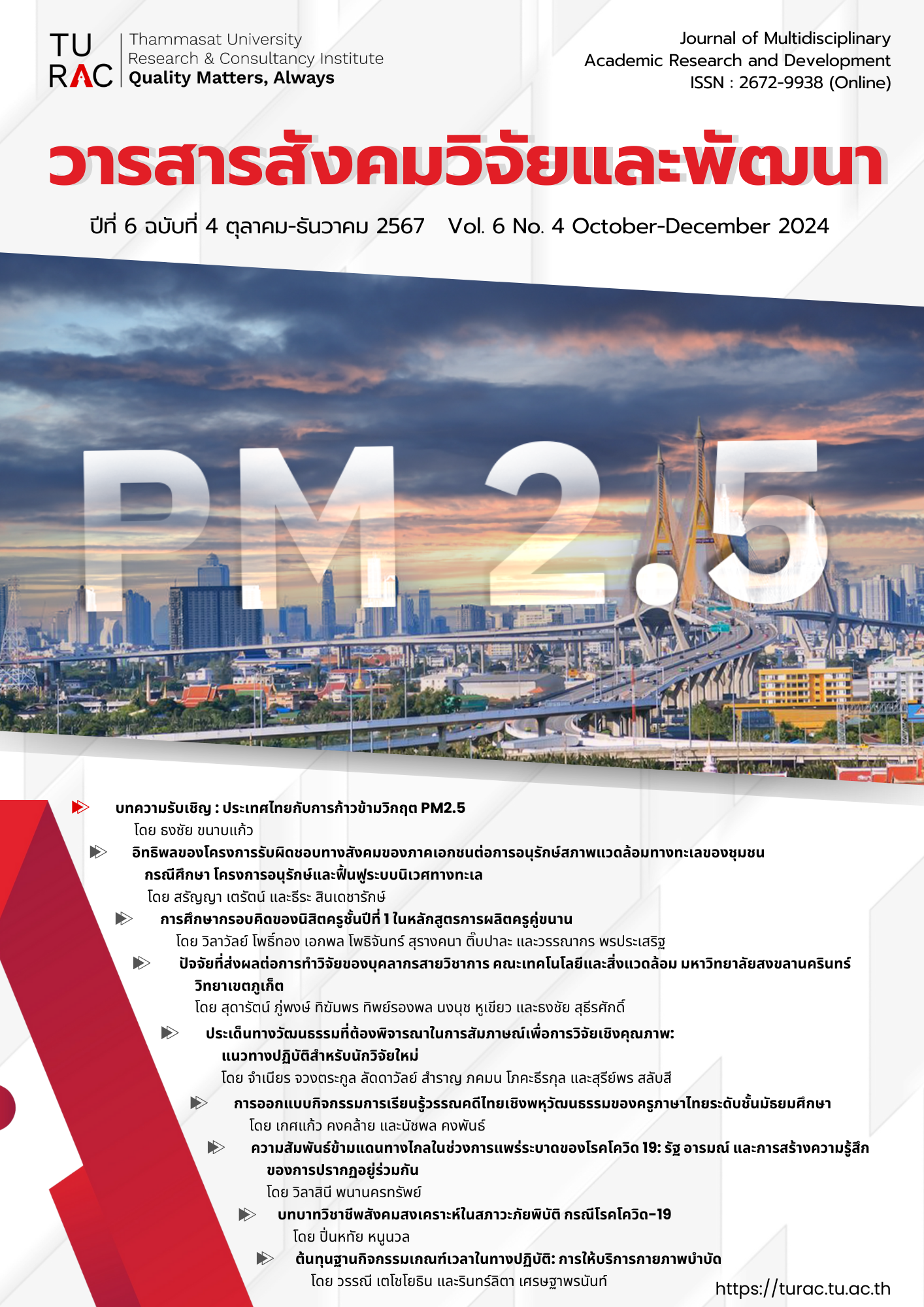Thailand and Overcoming the PM2.5 Crisis
References
กรมควบคุมมลพิษ. (2562). แผนปฏิบัติการขับเคลื่อนวาระแห่งชาติ การแก้ไขปัญหามลพิษด้านฝุ่นละออง. สืบค้นจาก https://www.pcd.go.th/strategy/แผนปฏิบัติการขับเคลื่อนวาระแห่งชาติ-การแก้ไขปัญหามลพิษด้านฝุ่นละออง.
กรมควบคุมมลพิษ. (2565). การศึกษาสัดส่วนแหล่งกําเนิดและองค์ประกอบของฝุ่นละอองขนาดไม่เกิน 2.5ไมครอน (PM2.5) ในกรุงเทพมหานคร.
กระทรวงอุตสาหกรรม. (2565). ก.อุตฯ จับมือชาวไร่ โรงงานร่วมแก้ปัญหาอ้อยสดสกปรก อ้อยไฟไหม้ก่อนเข้าโรงงาน ลดปัญหามลพิษ PM2.5 ส่งเสริมคุณภาพชีวิตที่ดีให้แก่เกษตรกร. สืบค้นจากhttps://www.industry.go.th/th/info-promo/10267.
ไทยพีบีเอส. (2562). ฝุ่น PM2.5: กทม.ประกาศ 50 เขตคุมมลพิษฝุ่น-ปิดโรงเรียน 437 แห่ง. สืบค้นจาก https://www.thaipbs.or.th/news/content/277363.
ธีรวัฒน์ น้ำคำ และเริงชัย ตันสุชาติ. (2564). ผลกระทบของฝุ่นละอองขนาดเล็ก PM2.5 ต่อจำนวนนักท่องเที่ยวต่างชาติในจังหวัดเชียงใหม่และกรุงเทพมหานคร. วารสารวิจัยราชภัฏเชียงใหม่. 22(3), 19-35.
นเรศ เชื้อสุวรรณ. (2565). แหล่งที่มาของฝุ่นละอองขนาดเล็กกว่า 2.5 ไมครอนในพื้นที่กรุงเทพฯ และปริมณฑล.
สำนักข่าวอิศรา. (2562). รร.-มหาลัยทั่ว กทม. ประกาศหยุดเรียน 30 ม.ค.-1 ก.พ. 62. สืบค้นจาก https://www.isranews.org/content-page/item/73357-pm2-5-733571112.html.
สำนักงานการวิจัยแห่งชาติ. (2564). วช. สนับสนุนงานวิจัย PM2.5 ยกระดับพัฒนาเทคโนโลยีและนวัตกรรมเพื่อแก้ปัญหา PM2.5. สืบค้นจาก https://pm2_5.nrct.go.th/newsdetail/284.
Bowe, B., Xie, Y., Li, T., Yan, Y., Xian, H., & Al-Aly., Z. (2018). The 2016 global and national burden of diabetes mellitus attributable to PM2.5 air pollution. The Lancet Planetary Health. 2(7), e301-e312.
Chansuebsri, S., Kolar, P., Kraisitnitikul, P., Kantarawilawan, N., Yabueng, N., Wiriya, W., Thepnuan, D., & Chantara, S. (2024). Chemical composition and origins of PM2.5 in Chiang Mai (Thailand) by integrated source apportionment and potential source areas. Atmospheric Environment. 327. Retrieved from https://doi.org/10.1016/j.atmosenv.2024.120517.
Hongthong, A., Nanthapong, K., & Kanabkaew, T. (2022). Biomass burning emission inventory of multi-year PM10 and PM2.5 with high temporal and spatial resolution for Northern Thailand. ScienceAsia. 48(3), 302–309. Retrieved from https://doi.org/10.2306/scienceasia1513-1874.2022.040.
Inlaung, K., Chotamonsak, C., Macatangay, R., & Surapipith, V. (2024). Assessment of transboundary PM2.5 from biomass burning in Northern Thailand using the WRF-Chem model. Toxics. 12(7). Retrieved from https://doi.org/10.3390/toxics12070462.
Kanabkaew, T. (2011). Assessment of effects from crop residue field burning on particulate matter air quality in Thailand. Retrieved from http://203.159.5.9/ait-thesis/detail.php?q=B11296.
Kumar, I., Bandaru, V., Yampracha, S., Sun, L., & Fungtammasan, B. (2020). Limiting rice and sugarcane residue burning in Thailand: Current status, challenges and strategies. Journal of Environmental Management. 276. Retrieved from https://doi.org/10.1016/j.jenvman.2020.111228.
Seinfeld, J. H., & Pandis, S. N. (2016). Atmospheric chemistry and physics: from air pollution to climate change. Wiley.
Yang, L., Li, C., & Tang., X. (2020). The Impact of PM2.5 on the host defense of respiratory system. Frontiers in Cell and Developmental Biology. 8. Retrieved from https://doi.org/10.3389/fcell.2020.00091.
Downloads
Published
How to Cite
Issue
Section
License
Copyright (c) 2024 Journal of Multidisciplinary Academic Research and Development (JMARD)

This work is licensed under a Creative Commons Attribution-NonCommercial-NoDerivatives 4.0 International License.


